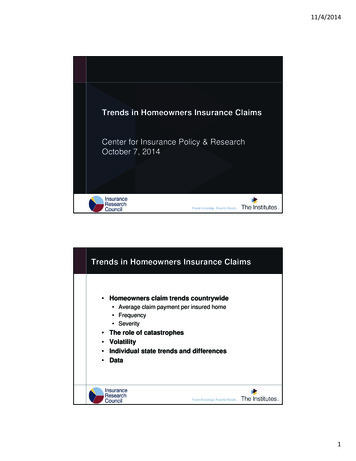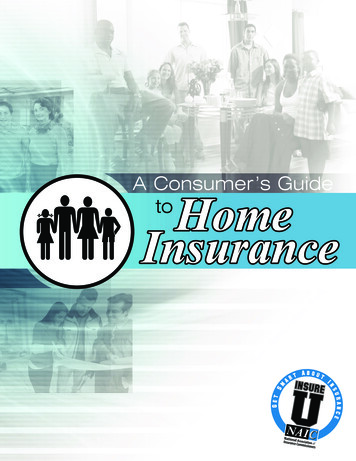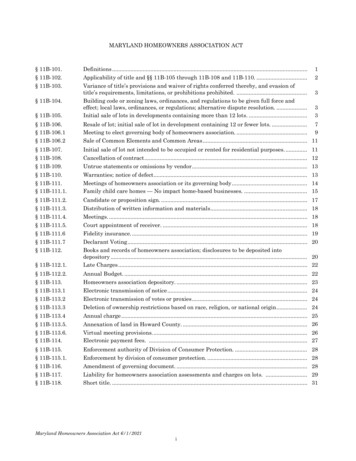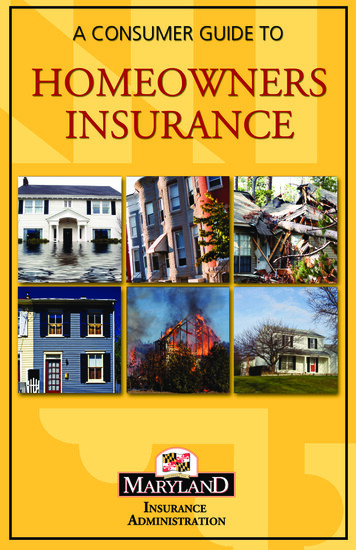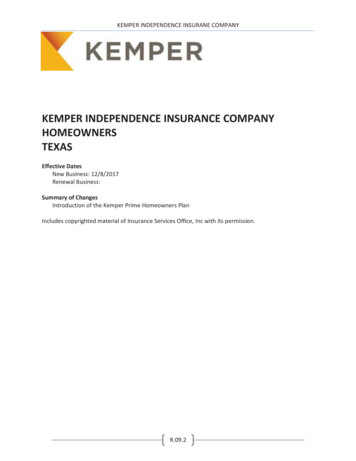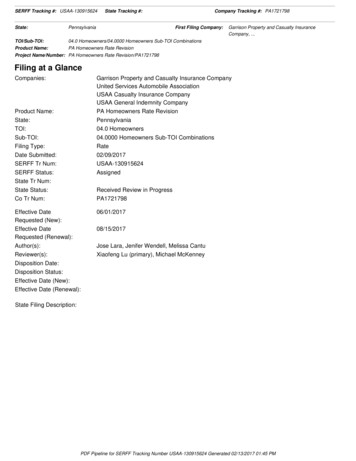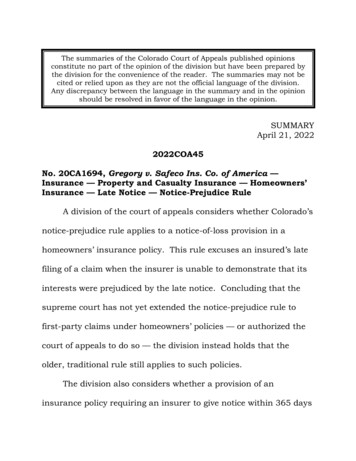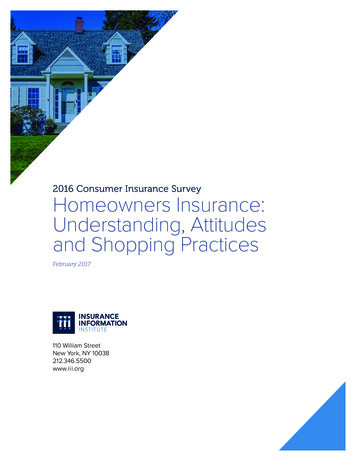
Transcription
2016 Consumer Insurance SurveyHomeowners Insurance:Understanding, Attitudesand Shopping PracticesFebruary 2017110 William StreetNew York, NY 10038212.346.5500www.iii.org
TABLE OF CONTENTSIntroduction: Consumer Insurance Survey Shows Knowledge and Gaps.1Key Findings. . 2The Need for Education .2I.Homeowners Insurance: Affordability and Purchasing Practices .3Improving View of Homeowners Insurance Costs.3What About Renters?.4Age Makes a Difference . 4Supplemental Natural Disaster Insurance .5Low Purchasing Rates of Flood Insurance.5Homeowners Lack Coverage for Earthquake Damage.6II. What Consumers Know—and Don’t Know—About Their Homeowners Coverage.7Fuzzy on the Details.7Understanding Theft Coverage.7It Came From the Sky .8Incorrect—and Potentially Costly—Assumptions About Coverage.9Flood Damage Is NOT Covered .9The Earth Is Moving! .10Other Gaps in Standard Homeowners Policies.10What About Liability Coverage?.1 1Peace of Mind With Living Expense Coverage.12III. Conclusion: Shopping for Homeowners Insurance in a Changing World.13Ways Homeowners Shop for Insurance.13New and Increasing Risks . 14Identity Theft.14Other Impacts of Technology.14Changing Weather Patterns.14Final Thoughts .15Insurance Information Institutewww.iii.org
INTRODUCTION: CONSUMERINSURANCE SURVEY SHOWSKNOWLEDGE AND GAPSWELCOME TO THE INSURANCE INFORMATIONINSTITUTE’S REPORT ON THE RESULTS OF OUR2016 CONSUMER INSURANCE SURVEY.We conducted this survey to collect and measurea range of information about consumers and homeowners insurance, including: The depth of consumer understanding about theirhomeowners insurance coverage; Policyholders’ attitudes toward the cost of homeowners insurance; The prevalence of purchasing separate policies tocover flood and earthquake damage; How consumers comparison shop for homeownersinsurance.The I.I.I. Consumer Insurance Survey was conductedin May 2016 via live telephone interviews with 1,006adults (18 years and older), residing in the continentalInsurance Information Institutewww.iii.orgUnited States. The data presented is proportionallyrepresentative of the U.S. adult population.We enlisted the aid of ISO , a Verisk Analytics business, to make certain that the losses wediscussed were or were not covered by standardhomeowners insurance policies. ISO is a widelyrecognized authority for policy standards.Answers reveal a wide range of results that point tosome interesting (and sometimes surprising) facts andtrends, including: policyholders decreasingly view thecost of homeowners insurance as a financial burden;the percentage of renters with renters insurance rosesubstantially between 2011 and 2016; many homeowners incorrectly believe that flooding is covered bystandard homeowners insurance; and many homeowners are not aware of the perils that are coveredby standard policies.1
Key Findingsfrom their home or if someone is injured on theirproperty (Fig. 1).Two broad conclusions can be drawn from theI.I.I.’s survey. First, the majority of homeowners dounderstand the basics of their homeowners policy.They recognize that they will be covered if theirhouse is damaged by a fire, if property is stolenBut second, homeowners have gaps in their knowledge of their coverage. For example, many policyholders do not recognize that most flood damage isnot covered by their basic homeowners insurance.Fig. 1Misunderstanding of FloodDamage CoverageHomeowners Understandthe BasicsPercentage of homeowners who knewkey perils are covered91%43%Fire damage69%79%91%79%Theft from house69%Medical costs for someoneinjured on propertyThe Need for EducationThe fact is, insurance policies are complex but understandable legal agreements. Consumers can—andshould—educate themselves about their coverage,recognize that they may have gaps in their coverageand seek guidance from an insurance professionalwhen they purchase or renew a policy.Surprisingly, the I.I.I. Consumer Insurance Surveyfound that only 44 percent of homeowners comparison shop for insurance by any method when theirpolicy comes up for renewal. When they do shopInsurance Information Institutewww.iii.orgof homeownersincorrectly believedamage from heavyrain flooding iscovered under theirstandard insurancepolicyaround, the most popular method is to speak with aninsurance agent in person. Only 17 percent of homeowners compare prices online at renewal time.Shopping for Homeowners InsuranceThe insurance industry has an opportunity to serve itscustomers and improve consumer understanding ofits products and services by increasing educationaloutreach to homeowners. Consumer advocates andthe media can also help close the knowledge gapby bringing attention to the need for homeowners tolearn more about their insurance coverage and seekprofessional guidance when they purchase insurance.2
I. Homeowners Insurance: Affordabilityand Purchasing PracticesBecause mortgage lenders generally require customers to insure their homes, the vast majority ofAmerican homeowners—about 93 percent—maintainat least basic homeowners insurance. It is simply afixed cost of owning a home, though rates vary widelydepending on where you live.Improving View of HomeownersInsurance CostsThe good news is that Americans decreasingly viewthe cost of homeowners insurance to be a financialburden. The I.I.I. Consumer Insurance Survey foundthat only 31 percent of Americans consider homeowners insurance to be a financial burden. This is thelowest level in more than a decade, and representsa significant drop from the 49 percent of people in2009 who said the cost of homeowners insurancewas a financial burden (Fig. 2).Fig. 2Financial Burden of Homeowners InsurancePercentage of Respondents Indicating That Homeowners Insurance Is a Financial surance Information Institutewww.iii.org35%201531%20163
What About Renters?Unlike homeowners with mortgages, renters are notconsistently mandated to purchase renters insurance.That said, many landlords do require their tenants topurchase renters insurance as part of a lease agreement. This requirement, however, is banned or limitedin some states and cities.Between 2011 and 2016, the percentage of renterswith renters insurance rose substantially, from 29percent to 41 percent (Fig. 3). Notably, during thisperiod, the homeownership rate declined in the U.S.,falling from 66.3 percent in the third quarter of 2011 to63.5 percent in the third quarter of 2016.Fig. 3Renters With Renters InsuranceAge Makes a DifferenceIn one surprising twist, the I.I.I. Consumer InsuranceSurvey found that younger generations are morelikely to purchase renters insurance than olderAmericans. A greater percentage of both millennialsand Generation Xers purchase renters insurance thanBaby Boomers (Fig. 4).Fig. 4Purchase Rates of Renters Insuranceby Generation41%Millennials(ages 18-35)48%Generation X(ages 36-51)24%Baby Boomers(ages 52-70)29% e Information Institutewww.iii.org4
Supplemental Natural DisasterInsurancehovered between 10 percent and 14 percent since2010 (Fig. 5).Low Purchasing Rates of Flood InsuranceThe 2016 flooding in Louisiana, as well as floods inthe Midwest and elsewhere in the South, provided astark reminder of the damage that can be wreakedby excessive rain.With its history of hurricane and river flooding, theSouth has the highest regional rate of flood insurancetake-up. Fourteen percent of homeowners in theSouth purchase supplemental flood coverage. TheMidwest—which saw flooding in 2016 in Wisconsin,Missouri, Minnesota, Kansas and other states—has thelowest rate, at 8 percent.Flood damage is not isolated to high-risk flood zonesor areas prone to hurricanes. More than 20 percent ofclaims paid under National Flood Insurance Program(NFIP) policies each year go to homeowners living inlow- to moderate-risk flood zones.A standard homeowners policy does not coverdamage caused by flooding from heavy rain or ahurricane-driven storm surge. Despite public education efforts, a significant portion of homeownersmistakenly think that flood damage is covered by theirstandard homeowners insurance, without the need forsupplemental insurance. Flood insurance is availablethrough the federal government’s NFIP, however—asa separate policy.In addition to causing dozens of deaths, 2016 floodscaused billions of dollars in property damage.Unfortunately, many of these losses were uninsuredbecause most homeowners do not purchasesupplemental flood insurance. The percentage ofhomeowners who do purchase flood insurance hasFig. 5Homeowners With Flood 20152016Insurance Information Institutewww.iii.orgHomeowners With FloodInsurance by Region (2016)8%13%Midwest Northeast14%10%SouthWest5
Misperceptions About Flood Coverage43%Homeowners who think thatstandard homeowners insurancecovers damage caused byflooding from heavy rain28%Homeowners who think hurricanestorm surge flood damage is coveredHistorically, the most destructive U.S. earthquakeshave occurred in the West, primarily in California.Homeowners in the West purchase earthquakecoverage far more frequently than residents ofother regions (Fig. 6).Fig. 6Homeowners With EarthquakeInsurance by Region (2016)Most flood damage is NOT covered bystandard homeowners insurance.Homeowners Lack Coverage forEarthquake DamageProperty damage caused by earthquakes is also notcovered by a standard homeowners policy, thoughfire damage following an earthquake will usuallybe covered. Although earthquakes have causeddamage in all 50 states, only 8 percent of Americanhomeowners purchase separate earthquakeinsurance or add an earthquake endorsement to theirhomeowners policy.Misperceptions AboutEarthquake Coverage29%Homeowners who incorrectlythink that standard homeownersinsurance covers earthquakedamageStandard homeowners insurance doesNOT cover earthquake damage.Historically, the most destructive U.S. earthquakesInsurance Information WestIn recent years, there has been increased seismicactivity in the Midwest and South. Measurableearthquakes have occurred in Kansas, Oklahoma andTexas, as well as in Alaska, Arizona, Idaho, Nevadaand California. In 2016, the largest earthquake in theU.S. took place in Alaska. On September 3, 2016,Oklahoma experienced its largest earthquake ever,at magnitude 5.8. The quake caused one injury andbuildings in the town of Pawnee were damaged.The U.S. Geological Survey reports that increasedseismic activity in Oklahoma is caused by underground wastewater disposal associated with oil andnatural gas production. Other states with energy production and underground wastewater disposal mayalso be prone to greater seismic activity, suggestingthat consumers may increasingly be at risk of damagefrom earthquakes.6
II. What Consumers Know—andDon’t Know—About TheirHomeowners CoverageMost homeowners understand the key provisions ofa standard homeowners insurance policy. A majorityof homeowners recognize that their policy will providecoverage for damage caused by fire, wind and hail.Most also know that items stolen from their houseare covered (Fig. 7).Fig. 7Recognizing Covered PerilsFire91%Theft79%Fuzzy on the DetailsWhile homeowners understand the basics of theirpolicy, the I.I.I. Consumer Insurance Survey foundthat many policyholders were not aware of someadditional coverages included in their policy.For example, 79 percent of policyholders recognizethat their homeowners insurance provides coveragefor possessions that are stolen during a homeburglary. But policyholders often don’t recognize thattheir possessions are also usually covered when thetheft takes place away from home (Fig. 8).Fig. 8Off-Premises Theft CoverageWind79%Hail73%Burst pipes71%%Percentage of homeownerswho correctly say theseperils are coveredInsurance Information Institutewww.iii.org57%Theft ofpossessionsfrom your car46%Theft ofcamera whilevacationing30%Theft of child’slaptop whileat schoolHomeowners who know thatoff-premises theft is covered7
Personal belongings coverage includes itemsstored off-premises—this means they are coveredanywhere in the world. Some companies limit theamount to 10 percent of the total amount of coverage you have for your possessions. Keep in mindthat policyholders also share a portion of the costby paying their deductible.Policies may also set special limits on high-valuepossessions, such as jewelry or furs. You can extendyour coverage on valuables by adding riders to abasic homeowners policy.Key Terms Deductible—The amount paid bya policyholder before insurancecoverage kicks in, often 500 or 1,000. Endorsement—A provision addedto a basic insurance policy thatextends coverage or modifies termsand conditions. Floater—Added coverage formoveable property such as jewelryor musical instruments, offeringprotection for losses wherever theyoccur. Rider—Another term for“Endorsement.”Insurance Information Institutewww.iii.orgIt Came From the Sky!Basic homeowners insurance also covers many perilsthat consumers may not be aware of. In the recentI.I.I. Consumer Insurance Survey, only 27 percent ofhomeowners said their policy covered a meteoritestriking their home. While the chances of your homebeing struck by a meteorite are pretty slim, standardhomeowners insurance coverage will in fact be therefor you in the case of this rare event.The sky has other perils, too, old and new. A standardhomeowners policy covers damage from fallingairplane debris and will pay costs if your drone fallsand injures someone, although most policyholdersdo not recognize that they have coverage for theseevents (Fig. 9).Fig. 9Airborne PerilsAirplane or plane debrishitting your home44%A meteorite strikingyour home27%Falling droneinjuringsomeone12%%Percentage of homeownerswho correctly say theseperils are covered8
Incorrect—and PotentiallyCostly—Assumptions AboutCoverageFor many types of perils, homeowners may bepleasantly surprised to find that their insurancepolicy offers coverage when they didn’t expect it.Unfortunately, the I.I.I. Consumer Insurance Surveyshows that the reverse is true as well: Consumersoften think that certain events are covered whenthey’re not.Fig. 10Misunderstanding of Flood CoverageHeavy rainflooding43%Hurricanestorm surge28%Flood Damage Is NOT CoveredWhen it comes to water damage caused by weatherdriven, ground-level flooding, a basic homeownerspolicy does NOT provide coverage. For example,there is no coverage if:Tsunamistorm surge18% A hurricane storm surge damages your property; Heavy rains flood your basement; An overflowing river or creek damages yourhome; or Tsunami-driven water destroys your home.For coverage of these types of incidents, homeowners must purchase a separate flood insurancepolicy—available from the NFIP and a few privateinsurers. A significant portion of homeowners,however, believe that their standard homeownerspolicy will cover flood damage (Fig. 10).%Percentage of homeownerswho incorrectly believe theseperils are covered under theirstandard policyConfusion about flood coverage may arise fromthe fact that some types of water and storm-relateddamage are covered by a standard homeownerspolicy. For example, most homeowners insuranceincludes coverage for damage caused by wind-drivenrain, burst pipes and water leaking into your housebecause of a roofline ice dam.When it comes to water damage causedby weather-driven, ground-level flooding,a basic homeowners policy does NOTprovide coverage.Insurance Information Institutewww.iii.org9
The Earth Is Moving!In Section I, we discussed consumer misperceptionsabout earthquake coverage, which is not included ina standard homeowners policy. Other types of “earthmovement” events, such as mudslides, sinkholesand landslides are similarly not covered. A sizeableportion of homeowners think their policy covers oneor more of these events, when it does not (Fig. 11).Fig. 11Misunderstanding of“Earth Movement” CoverageSinkhole 31%Other Gaps in Standard Homeowners PoliciesUltimately, homeowners insurance policies aredetailed, complex legal contracts. While homeownersunderstand many components of their insurance,every policy has a range of stipulations and exclusionsthat are sometimes overlooked.It’s NOT Necessarily Covered!Percentage of homeowners who thinkthey have coverage for 55%SewerbackupMudslide24%Landslide 23%%59%Lightningpower surgedamage toelectronicsPercentage of homeownerswho incorrectly believe theseperils are covered under theirstandard policyHomeowners may be able to purchase supplementaryinsurance for “earth movement” events, and somestates have special requirements. Mudslide damageis covered under flood insurance policies; landslides,sinkholes and earthquakes require separate,specialized policies.Insurance Information Institutewww.iii.orgSome homeowners policies may provide coverage forthese events, under certain circumstances. Generallysewage backups are not covered without a rider orseparate policy.10
What About Liability Coverage?Homeowners insurance does more than providereimbursement for property damage. It also providesfinancial protection to policyholders from certain typesof liability.The I.I.I. Consumer Insurance Survey found that mostpolicyholders recognize that their standard homeowners insurance provides liability coverage in certaincircumstances, though there are many homeownerswho are not aware of this coverage (Fig. 12).Standard homeowners insurance will generally paymedical costs if someone—excluding a member ofyour household—is injured in your home, up to thepolicy’s limit. Your policy may also reimburse someonefor lost wages as a result of an injury in your home. Ifyou’re sued in response to the injury, your policy willlikely help you cover legal costs as well.Liability insurance also covers damage accidentlycaused by you or a household member to someoneelse’s property. For instance, if your daughter hits abaseball through a neighbor’s window and breaks aTV, both window and TV would be covered.In addition, a standard homeowners policy will paymedical costs if your dog bites or injures someone.The policy can be changed to exclude a specific pet.Fig. 12Understanding Liability CoverageMedical payments for visitor injured on your property69%Defense costs if sued by someone injured on your property61%Medical payments for a visitor bitten by your dog54%%Insurance Information Institutewww.iii.orgPercentage of homeowners who recognize that their standardhomeowners policy provides certain liability coverage11
Fig. 13Additional Living Expenses (ALE) Coverage48%Homeownerswho recognizethat their policyprovides ALEcoverage27%Homeownerswho don’t thinkthey havecoverageStandard homeowners insurance does include ALE coverage.Peace of Mind With LivingExpense CoverageHomeowners insurance helps you keep a roof overyour head—even if your house has been totallydestroyed by a fire or rendered uninhabitable bywind damage.Standard homeowners policies generally coverspecial living costs incurred when you cannot liveInsurance Information Institutewww.iii.orgin your home because of an insured loss. Coveredcosts include additional expenses for temporaryhousing, hotel bills, restaurant meals and otherexpenses.This provision—known as “Additional Living Expenses”or ALE coverage—can provide peace of mind and helpfamilies move past disasters. Most homeowners doknow that they have the coverage. (Fig. 13).12
III. Conclusion: Shopping forHomeowners Insurance in aChanging WorldThe I.I.I. Consumer Insurance Survey shows that mostpolicyholders do not comparison shop for homeowners insurance when it’s time to renew their policy.Only 44 percent of homeowners compare prices ofdifferent insurers at renewal time.As a point of contrast, in November 2015, 69 percentof consumers said they comparison shopped for autoinsurance when their policy comes up for renewal.This higher rate of comparison shopping may inpart reflect the fact that a greater percentage ofpeople view auto insurance as a financial burden,as compared to homeowners insurance (49 percentvs 31 percent).Ways Homeowners Shopfor InsuranceFor homeowners who do shop for insurance, themost popular method is to talk with an insuranceagent in person: 29 percent of homeowners saidthey met with their agent to compare prices fromdifferent insurance companies.Surprisingly, fewer than one out of five policyholders compares homeowners insurance pricesonline (Fig. 14).Fig. 14Shopping for Insurance:Homeowners vs. Auto44%Homeowners rsPercentage of policyholderswho comparison shop whentheir insurance is up forrenewalInsurance Information Institutewww.iii.orgComparison Shopping forHomeowners hop13
New and Increasing RisksA lack of understanding about homeownerscoverage is just one challenge facing policyholders.In addition, some risks—such as severe weatherdamage and identity theft—are on the rise. Policyholders can educate themselves about their coverageand new risks if they investigate their options carefullyat renewal.Identity TheftIdentity theft—the fraudulent use of someone’spersonal information to secure financial gain—is onthe rise. Identity theft often happens when bankingor credit card information gets into the wrong hands,following the theft of a checkbook or wallet. Butincreasingly, compromised computers, devices,and websites—hacking or cyber crime—can lead toidentity theft as well.Some homeowners policies provide coverage forlosses and expenses related to identity theft. Alternatively, policyholders can purchase an endorsementto their homeowners (or renters) insurance that willprovide identity theft coverage.Identity theft—the fraudulentuse of someone’spersonalinformation tosecure financialgain—is on therise.Insurance Information Institutewww.iii.orgOther Impacts of TechnologyA range of new technology-driven products andservices, such as smart home devices and peerto-peer rental apps, like Airbnb, are also impactinghomeowners insurance coverage and costs. Smart Home TechnologiesSome insurers are subsidizing the cost of smarthome technologies that can help lower the riskof fire, theft or water damage. Other financialincentives are available as well, including lowerpremium prices. Peer-to-Peer Home RentalOnline services, such as Airbnb and HomeAway,have enabled people around the country to turntheir homes into short-term rental properties.Homeowners who rent their property or evenjust a room on a regular basis need to purchaseseparate business coverage.Changing Weather PatternsAs we noted earlier in this report, flooding andearthquakes are on the rise. In addition to moreintense and erratic rainfall, we are also seeingsome areas of the country experiencing hotter, drierweather, which increases the risk of wildfire.The growing frequency and severity of catastrophicweather events makes it all the more important forhomeowners to review their policies and purchaseadditional coverage for risks that fall outsidebasic homeowners policies, such as flooding andearthquakes.14
Final ThoughtsHomeownership comes with a wide range of risks,and homeowners insurance is a complex product.While homeowners understand the basics of theircoverage, the I.I.I. Consumer Insurance Survey makesit clear that there is still a great deal of misunderstanding about what typical policies cover and don’t cover.Given the gaps in the average consumer’s knowledgeabout property and liability insurance, it is moreimportant than ever that the insurance industry,as well as consumer advocates, focus stronglyon educational outreach.In addition, with a wealth of resources availableonline and in the insurance marketplace, consumerscan educate themselves and make more informedchoices about their coverage. But first they needto recognize that they might be able to bettermanage their risks as well as save money.Learning Opportunities for ConsumersOnlineMany insurers, government agencies, and organizations such as theInsurance Information Institute at www.iii.org provide in-depth onlineinformation about homeowners insurance.By PhoneYou can shop for lower prices and improved coverage by calling around.Telephone representatives of insurers can answer questions aboutcoverage as well.In PersonIn advance of renewal, policyholders should consider meeting with theirinsurance professional to review coverage and ask questions.Read Your PolicyYou can learn about your coverage by closely reading your policy. Keepnotes of questions you want to ask your insurance professional.Insurance Information Institutewww.iii.org15
Appendix 1Consumer Insurance Survey Questions1.Renters insurance provides renters with financial protection against the loss or theft or destruction of yourpossessions when you rent an apartment or a house. For example, renters insurance would cover you ifyou had a loss because of a burglary or fire.It also covers your responsibility to other people who are injured in your home and for living expenses ifyou can’t live in your apartment because of a fire or other event. Do you have renters insurance? Yes No Don’t Know2.As far as you know, how much of a financial burden is it for your household to pay for auto insurance?Please use a scale from 1 to 7 where ‘1’ means paying for auto insurance is ‘not a financial burden at all’ and‘7’ means it is a ‘great financial burden’. If you don’t have auto insurance, please say so. ( 1 ) Not a financial burden at all (2) (3) (4) (5) (6) (7) A great financial burden Don’t have auto insurance Don’t know/refusedInsurance Information Institutewww.iii.org16
3.As far as you know, how much of a financial burden is it for your household to pay for homeownersinsurance?Please use a scale from 1 to 7 where ‘1’ means paying for homeowners insurance is ‘not a financial burdenat all’ and ‘7’ means it is a ‘great financial burden’. If you don’t have homeowners insurance, please say so. ( 1 ) Not a financial burden at all (2) (3) (4) (5) (6) (7) A great financial burden Don’t have homeowners insurance Don’t know/refused4.Standard homeowners and renters insurance policies do not cover flood damage. Flood insurance isavailable in the form of a separate policy both from the federally subsidized National Flood InsuranceProgram and from a few private insurers.Do you have a separate flood insurance policy? Yes No Don’t know5.Standard homeowners insurance policies do not cover damage from earthquakes. Coverage is availableeither in the form of an endorsement or as a separate policy.Do you have earthquake coverage, either as an endorsement or as a separate policy? Yes No Don’t know6.Does your homeowners insuranc
Financial Burden of Homeowners Insurance Insurance Information Institute www.iii.org 3 I. Homeowners Insurance: Affordability and Purchasing Practices Because mortgage lenders generally require cus-tomers to insure their homes, the vast majority of American homeowners—about 93 percent—maintain at least basic homeowners insurance. It is simply a
